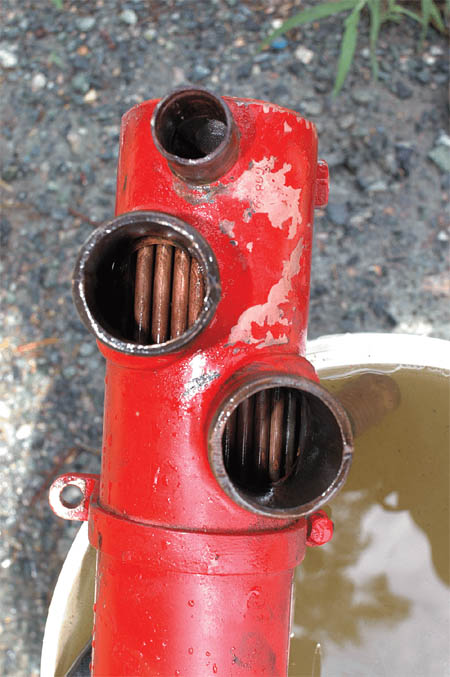|
WAY COOL: HEREíS WHAT YOU NEED TO KNOW ABOUT YOUR ENGINEíS COOLING SYSTEM AND THE COOLANT THAT FLOWS THROUGH IT.
Engine Cooling System
The tubes on the closed cooling side of this heat exchanger were fouled by a film that required solvent flushing, after which the change in color was clear to see
Most marine diesel engines rely on whatís known as a closed cooling system. As with an automobile engine, the heat of combustion is absorbed by antifreeze (or, more accurately, coolant). In a car, that heat is then released airborne, via a radiator; with a sailboat, itís transferred to the ocean via a heat exchanger.
Closed cooling systems, which typically operate at between 180 and 195 degrees F, offer several important advantages over open cooling systems. The latter allow seawater to flow through the iron engine, the predictable result of which is corrosion. Additionally, open cooling systems must operate at a cooler and less efficient temperature, typically around 150 degrees F, to prevent salt from precipitating out of the seawater and depositing itself within the cooling systemís passages, where it acts as an insulator and reduces the heat transfer efficiency. This comparatively cool operation promotes the formation of carbon within cylinders.

Perhaps the most important advantage of a closed cooling system is the pressure under which it operates, typically between 6 and 15 psi. The pressure is important for a couple of reasons: First, while coolant already has a higher boiling point than ordinary water, the pressure further increases the boiling point of the coolant (for each pound of pressure applied, the boiling point rises about 3 degrees F). Second, and even more important, the increased pressure reduces the occurrence of cavitation within the cooling system. Cavitation, the rapid creation and violent collapse of vacuum bubbles, can be destructive, as each implosion can scour away metal from the cooling passages.
Unless you purchase it pre-mixed, coolant should be mixed in equal parts with distilled water. (Distilled water contains no minerals, which can be deposited inside the closed cooling system.) How often should you replace coolant? Many engine manufacturers specify two-year intervals. However, depending upon the cost of replacement, sending the coolant to a lab for analysis, may make more sense, especially if it extends the period to three or four years. (Some extended-life coolant is rated for six years or 14,000 hours, but it should also be analyzed annually.)
Alternatively, coolant test strips can be used for field analysis, although they yield less definitive results. When you do replace or top up coolant, avoid mixing brands and types, and stay with those recommended by the engine manufacturer; at the very least, use coolant designed specifically for diesel engines. Every few months, when the systemís cold, closely inspect the pressure cap and neck for corrosion, gasket failure or other defects. When doing so, check the coolant as well. It should look clean and bright; green, blue or orange; and never rusty.
Now back to that chronically overheating engine. The culprit turned out to be a little-known phenomenon wherein a film forms inside the closed coolant side of the heat exchanger. The result of a previous overheating episode, the film inhibited heat transfer, which led to the chronic high-speed overheating. Flushing the heat exchanger with a proprietary solvent removed the film and put the temperature gauge back in the green. The moral of this story is twofold: One, systematic analysis will eventually lead you to the cause of the problem. And two, once overheated, coolant should always be replaced and the closed cooling system flushed to prevent future overheating.
Source - cruisingworld.com
|








